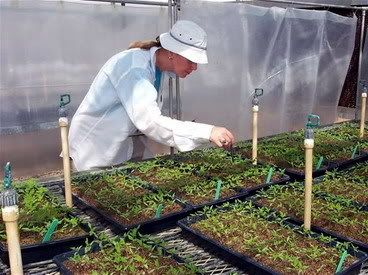Hydroponic Gardening - Managing Pests & Diseases
By Michael Page
As with soil-based gardens, hydroponic plants require good pest and disease maintenance controls. Failure to do so creates the same results as with 'ordinary' gardens i.e. spindly or dead plants. Since the majority of hydroponic plants are fruits and vegetables, that means the plants are not worth eating.
However, managing the hydroponic garden is even trickier, since disease and pests have it much easier in this setting. Plants are continuously kept wet, either immersed in water ('true' hydroponics) or continually sprayed (aeroponics) or reside in a permanently wet medium such as perlite or sand. Fortunately, as with soil-based gardens, there is an large array of available methods to manage the problem.
Using beneficial life forms is one popular way to control unwanted pests, including certain types of bacteria and fungi. These can help to control spider mites and other invaders by crowding them out, eating them or releasing compounds toxic to the pest. They're known as beneficial organisms because they do all that without damaging the plants themselves.
Different types of pesticides are available, too.
Pesticidal soaps have been in use for centuries and still provide effective and non-toxic ways to keep the pests down. One category called botanicals are compounds released by plants themselves that have been combined into an easy-to-use pest control method. Botanicals break down naturally from exposure to air and water and are brilliant because they leave no harmful chemicals behind.
Neem oil can control over 400 different types of pest that commonly invade gardens, including hydroponic ones. A simple spray to the leaves can often eliminate common pests. The bugs absorb the oil, which limits their ability to reproduce, leading to a lower population.
For more serious infestations, many commercial pesticides continue to work well.
White flies, aphids, mites and other pests can be a problem in hydroponic settings, just as in soil-based gardens. Powdery mildew is common. In fact, because of the continual moisture bugs and pests have a 'friendly' environment. Making it 'unfriendly' is straightforward enough, using fungicides and organicides. Sulfur-based compounds can help control white flies, mealy bugs, thrips and more.
Pyrethrum continues to be a safe and effective means of control. Though it sounds man made it is actually derived from flowers. This class of natural compounds released by plants are extracted and used in many commercial insecticides. Dosage is low, so the compound is very safe when used correctly (always read the label). Azatrol is a broad spectrum insecticide that provides another easy control method over most common pests.
Hydroponic gardeners have to exercise additional care when using any disease or pest control method, though. Since no soil is present to hold on to the roots, it's easier to damage a plant when manipulating the leaves and stems. That means that if you pick off mites by hand - an effective method for low-number infestations - it's important to exercise extra care.
Since moisture is present, mildew and other fungi are more common in hydroponic gardens. Keeping leaves dry and just the roots wet will help. Any insecticide sprayed on to your plants or vegetable should be allowed to dry under the grow lights. For aeroponically grown plants, for example, that may require a temporary relocation of the indoor garden.
To learn more about Hydroponic Gardening visit the Hydroponics Store where you'll find more information including an extensive range of Hydroponic Pesticides Sprays and other Hydroponic Gardening Equipment
Managing Pests & Diseases
10:04 PM
ThanateTan







